Maia Lehr-Sacks, South Africa
“The Little Paper House”
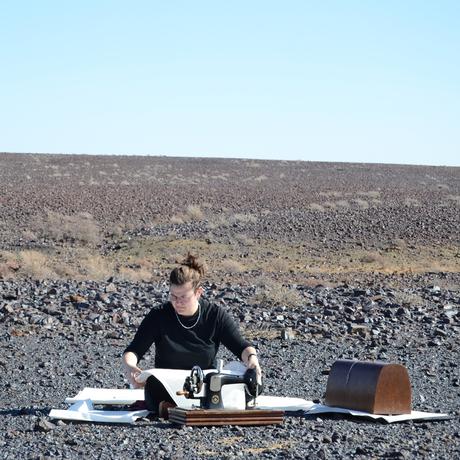
Returning to the Tankwa Karoo, I had this image of a white paper tent there. Stark against the black rocks. Inadequate against the elements. While I wanted to create a work that engaged with the landscape and spoke about fragility, I had no idea the extent to which the process of making and erecting this little paper house would affect me. Over the course of the residency, sitting everyday sewing sheets of paper together with my hand-powered Pfaff sewing machine, feelings of vulnerability and childhood homesickness emerged.
Being in the Tankwa, I found the landscape itself to be deeply confrontational. I experienced being truly alone for the first time in a long time. It became clear very quickly that there was nowhere to hide from myself. Nothing to distract me from the facts of my current existence. As challenging as this was there was also a deep exhilaration in the fact that the masks and facades that frequented my urban existence had no place there.
The powerful and fragile landscape that instilled in me a desperate consideration for the consequences of my every move, was contrasted by the warmth and openness that existed within the group of people present within the same space. The freedom to create and collaborate was refreshing. The connections that were made with each other through relating our profound experiences of being within this sacred landscape were deeply meaningful to me.
At the end of the residency, I erected my tent. It lasted probably twenty minutes before the wind ripped it to shreds. I burnt the remains that night. The destruction of this delicate shelter was a necessary process of personal release. The tent spoke about the endless longing to feel at home in the spaces that I inhabit and the inadequacy of the home I seem to try and find within myself. Somehow in this deeply foreign and unfamiliar landscape, I found some kind of unexpected solace and comfort that surprised me. The loss of the tent was a reminder that, while I experience an endless longing to feel at home, in the same breath, there is an equally strong desire to be free of the threads of the past.
Janet Botes, South Africa
“DNA of the Tankwa Veld”
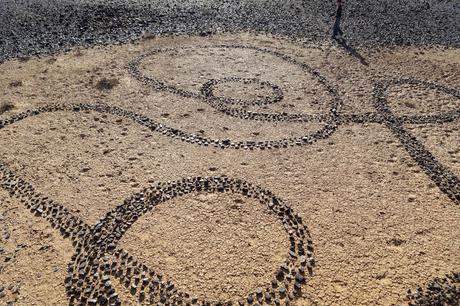
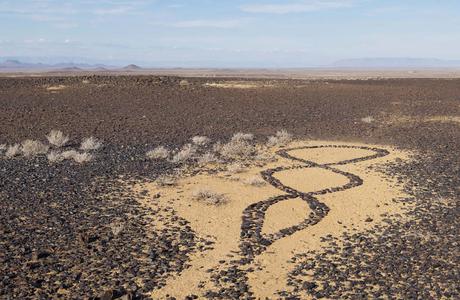
Photos Kleoniki Vanos
I feel incredibly privileged to have been one of the artists for the 2019 Tankwa Artscape Residency. The residency itself, the camp, my creative process, the sites, the landscape, the sunsets, sunrises, and the interactions with my fellow artists, hosts and photographers all-together created one of the most sacred experiences of my life up to now.
My intention for the residency was to be guided by my physical, bodily experience of the landscape. In some ways I did not quite achieve what I planned, but in other aspects I’ve gone beyond what I intended. Using clear and simple symbolism to express universal concepts, like the simplified DNA line, which also symbolizes a body, with spiritual grounding cords that flow and curve in the ‘Earth’ on the pan on the other side of the road.
Whether directly or indirectly, the land art and universal symbols were born from my bodily experiences – my work for the week also included licking stones, walking barefoot on rough rocks and rolling with bare skin onto the sand. This evoked not only physical sensations, but also an unveiling of myself, an emotional upheaval at times, and a general openness, not only to the land, but also with myself and with the people around me.
I created a “Rock Gemsbok” after undoing a land art piece and reverse-engineering the site, for what would’ve been my body’s silhouette. My body was too much of a physical imprint of MY will, MY body, MY idea onto land that has already been impacted and transformed by human agriculture in earlier years, and by killing all the wildlife that originally trekked the land. The land does not need the impression of another human body, but rather more tracks and traces of animal life.
I wonder and I wander.
Timelessly, aimlessly, lovingly, awestruck.
Finding more. Feeling more. Knowing myself more
As I feel and explore deeper into the sea of rocks
and how it connects to my female body
Hard versus soft,
Unyielding versus pliable.
The stillness of the rocks says SO much
If I just sit still long enough to listen.
Kimberly Burger and James Mader, South Africa
“Eensam”
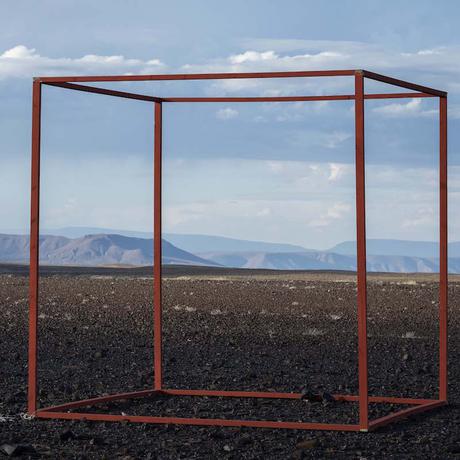
The Tankwa desert reminds us loudly of our impermanence, surrounded by ancient undisturbed rocks we can’t help being reminded of our own transience. In this place we must tread lightly, in reverence.
“Eensaam” looks at our relationship to landscape and space, how we define and are defined by the places in which we find ourselves. Through the cube, a vessel, a physical representation of space, we created a stage on which humans can interact with the vastness of a full and perfect landscape. We bring a piece of our own space into this place and impose ourselves on the ancient land to briefly have a say. As impermanent as us and our ideas the cube left the desert and it will reappear in a new landscape where we start again.
AKUNZO, The Netherlands
Karola Pezzaro & Aris de Bakker
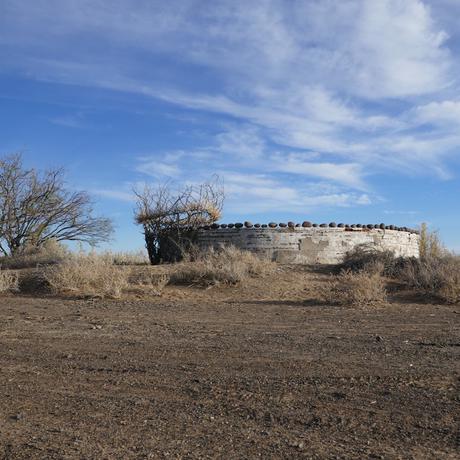
In 2018 we had made a work ‘Take a Moment’ for Horizons Sancy in France. Because of this work we got an invitation to participate in the Tankwa Artscape Residency in the Tankwa desert in South Africa. Artists from different disciplines come to work in this residency: visual arts, land-art, performance, sound, dance. And also photographers who record the work processes in photo and video.
The participants camp in tents on a vast stony plain surrounded by mountain ranges in the distance. It is an unruly landscape. Hills with round or extremely sharp boulders, stone plains, dry river beds with spine bushes in shades of white, light gray, soft green, yellow and sometimes red. Here and there are Acacia trees, invaders from Australia that apparently can produce long roots. You might see a single bird, lizard, beetle, fly or a butterfly. There are also ibex, gazelles, and adders living here, but unfortunately we don’t get to see them. Silence (sometimes you only hear it whizzing in your own head) and dark nights with a sky full of stars.
As an introduction on the first morning we are dropped somewhere in the area and then walk back on our own to the camp (the mountain with the nipple serves as a landmark). We walk our own route, winding or in a straight line, slowly, pausing, continuing. In this way everyone gets a truly personal and sensitive experience of the environment.
In the afternoon we look at artworks that were made in previous years. The organization has learned from this and changed the goals of the residency. They no longer want artworks that stand as signal images in the landscape, ‘no egos on top of a hill’. After the morning walk, this feels like a logical decision. One does not want to disturb this landscape. Also the wish to realize more ephemeral works, to have space for the artists to play, explore and investigate, and to work only on sites, which have previously been disturbed by humans, fits in with this, as does the choice of artists from different disciplines.
With one of the owners of the Nature Reserve we look for a place to make our artwork. At the end of our expedition we arrive at a dry water reservoir. Our intuition tells that this is the place. Bushes, remains of a fence, an attempt to cultivate a field. An old bird’s nest in the bush and bees in the former water pump. The water reservoir itself is round, made of brick and plaster. The diameter is approximately 7 meters.
The rawness of nature is overwhelming here. All shrubs have spines, so that – if there are leaves – goats do not immediately eat everything. The gray dead branches that we find are tough and hard. Everything that wants to live here must make a huge effort. People’s attempts to exist here are clearly in vain. Yet there is also a bird’s nest, there are bees, we see beetles. In our eyes, the reservoir makes an embracing gesture, it carries the dream of water, life and growth. When we draw, a comprehensive, nurturing form arises, leaning against the reservoir, as a counterbalance to the harsh environment. We decide to use only materials that we can find in the immediate vicinity of the basin.
We weave a structure from the bottom of the reservoir with gray dead branches that embraces a part of the wall. The branches stick out in a natural way, as if a new bush has emerged. A bit above the edge of the reservoir we create a horizontal boat-like shape in the structure by weaving a double line of branches. On this we place an exuberant amount of coral-like white twigs, which grab up like claws. These coral-like twigs are the dead remains of a special plant that has ‘green fingers’ when alive. We experience the twigs as a subtle hint to the former seabed.
At the top of the reservoir we lay one by one round and egg-shaped dark boulders that connect the reservoir and the structure of branches like a chain.
The installation blends into the landscape, because it is built in the same colors and materials. As you approach from the hill it will only become visible when you get closer. Looking from the top of the hill nothing seems to have happened.
We call our work Echo of the Desert.
Kim Goodwin, South Africa
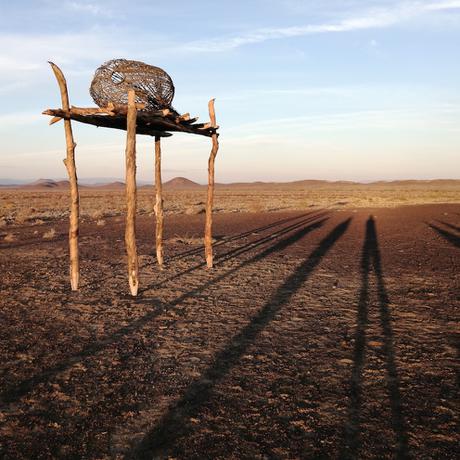
Video Josie Borain, Bronwen Trupp, image Niel Jonker
Capsule: to equip with or enclose in
to condense into or devise in a compact form
Material: Wood, wattle, bronze, steel
Most of my thoughts and ideas for building in the Tankwa involve and are steered towards the /xam Bushmen who lived in this region. Capsule is an idea that I’ve been working on for a while now and involves holding the story of these people in a protected sacred space.
JP took me to an area on Stonehenge, which he thought could work/hold an installation. The piece is specifically designed for this area.
All the technical and logistical issues worked out perfectly, however, as all artists know, the idea behind the installation and the inner dialogue that ensued, became an interesting part of this journey. Creating an installation that was gentle on the landscape and yet moving to the viewer became my priority.
Although it is important to have an audience, the idea that this installation will stand most of the time, alone, in all the beauty of the Tankwa, is as important to me.It is a privilege to have been able to place this piece on this landscape.
Julia Drouhin, France | Australia
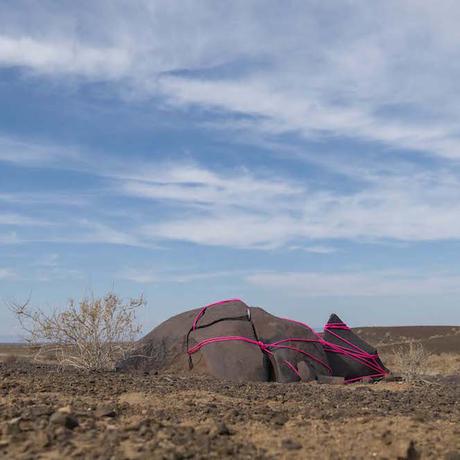
Photos Tegan Green, Kleoniki Vanos
During the Tankwa Artscape residency, I wanted to amplify what was happening there. I had time to test radio cheerleading, radio sun jacket kite, munching rocks through megaphone, climbing the horizon, cleaning my foot print (and left a bigger trace), sailing in the puddle of garbage, walking on a magnetic line, being awake by the sound of an insect…
What do we absorb, conduct, how do we restitute, destitute? What is the sound? A question? A scream? An absence?
We can’t hide ourselves here, we challenge our humanity in this already full canvas.
Bubbles of earth
Frozen in time,
When hot and cold met
At the bottom of an inland sea,
Leaving the pressure to humankind
Who don’t know
How to air it.
I temporarily tied the knots with a rock before I released the tension when I left. After having been introduced to licking rocks by Janet Botes, I started to feel intimate with this one, and asked if it came from around here or from outer space, how did it break…
This pink rope in this landscape, intrusive like humans, is a visible sign of a failing attempt to fix some damage and reflect on lines and limits that we add in natural environments but also an emotional attachment that can take us to loose our grounding.
I dissolved in the Tankwa landscape time.
For an instant nothing mattered.
Leli Hoch, South Africa
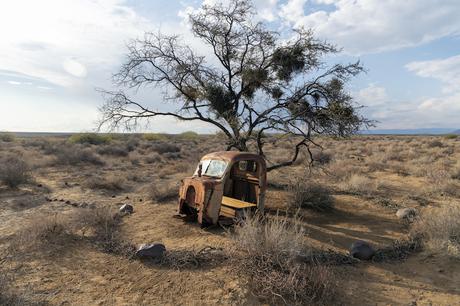
Video and image Kleoniki Vanos
“The Heart of Wisdom”
I created a sanctuary of meditation under the only indigenous sweet camel thorn tree (Acacia Erioloba) left on the banks of a mostly dry tributary to the Tankwa Riverbed using three different symbols: the front part of an old truck as a symbol for Western materialistic thinking, a meditation bench inside it, looking onto the figure of a joyful Buddha on the hood of the truck as a symbol of Eastern philosophies, and the fact that both are in the shade of a sweet camel thorn tree, under which African people used to gather and converse.
Silence is not the absence of something but the presence of everything, the presence of time, undisturbed (Gordon Hempton)
“The Broken String”
Poem by Stephen Watson based on
Because of a broken string
because of a people breaking the string
the earth my place is the place of
something, a thing broken,
that does not stop sounding breaking with me
Dia!kwain’s /xam story, Lloyd Bleek Collection
Quentin Dibley Green, South Africa
“Reservoirbration“
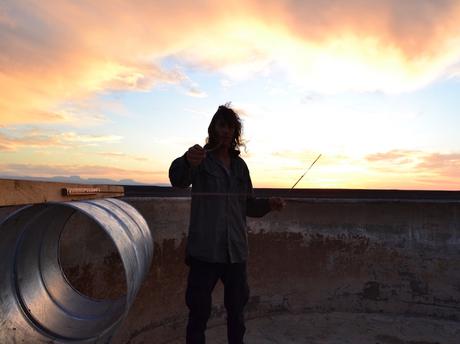
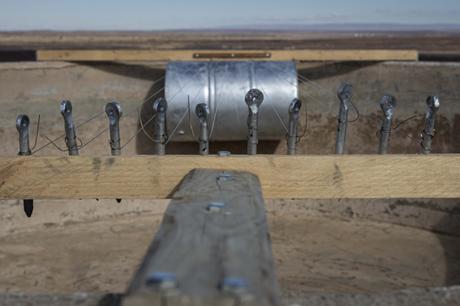
The residency offered Artists the opportunity to immerse in the unique landscape , commune together and create work which compliments and belongs in the environment.
Inspired by my 2018 experience, I returned with intentions to work with sound and form.
I repurposed a derelict reservoir into a sounding instrument, to create soundscapes in the ‘silent’ environment. It also works as a sound theater where observers can sit in the resonant space and experience ‘unpolluted’ unplugged sound. The Reservoirbration will draw me back to play and reveal the secrets it still holds, ‘ a dam full to the brim with potential’.
“Egg #3”
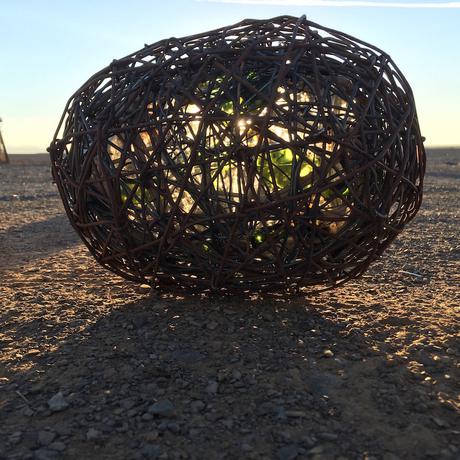
My second work was a sculpture inspired by my previous visit. The egg represents the future, residing in the present, remembering the past. It is based on the concept of upcycling, reevaluating our impact on Nature.
The irony of pollution is signified by the materials obtained from Earth (iron and silica), which become pollution – collected from the dump – and recreated into an object with glittering allure.
The egg #3 was placed in my ‘nest’, hidden in the landscape, with egg #1 and egg #2
“Circle of Reflection“
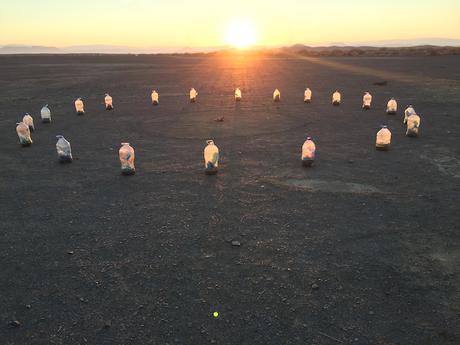
I created this installation close to our camp inspired by the conversation from our daily gatherings in a circle. My intention was to create a conversation between objects and light and between the community and the objects.
I created a sacred space in the middle, which hosted the subject – objects I collected, including a dog skull, a hide, a clock – and in conclusion a meeting place for my Eggs before they went into the landscape. The bottles contained discarded water, Tankwa sand and trash.
Video Kleoniki Vanos
My sound work was a daily activity as I played the landscape and collaborated with artists.
- Sonya Rademeyer – I played umhrube for her drawing in the sand performance.
- Kimberly Burger – I played kalimba, supported by her partner James Mader playing the rainstick – while she danced.
- Aris de Bakker and Karola Pezarro – I played umhrube while they played the stones as we blessed their beautiful installation.
- Hanien Conradie – I played the bullroarer for her performance
- I gifted the residency a sound journey under the moonless star-spangled sky. Truly an incredible experience as we travelled from utter silence and solitude on a magical soundscape, into a supplicant state, on our backs, sandwiched between heaven and earth, back to silence and the Tankwa bus.
- I played the djembe, didgeridoo, kalimba, rainstick, harmonic flute, jaw harp, iqangala, drum harmonic and gong.
Sonya Rademeyer, South Africa
“Please forgive me”
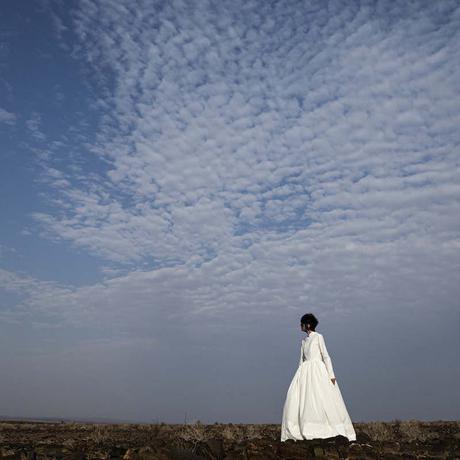
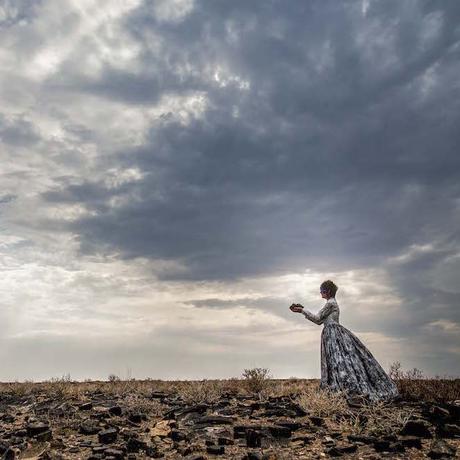
Please forgive me enacts the state of experience of post-traumatic memory of the politics of land. Using the specific geographical landscape of the remote Tankwa Karoo to embed a series of short performances, the work is placed within the social history of early colonization when the first European settlers took land from those to whom it belonged to, namely the hunter-gatherer San (Bushmen) and the pastoral Khoekhoe.
Moving from an inside place and a personal position, the work links present to past memories through a series of performance pieces. Initially departing from my own genealogy, I deconstruct the documentation of my ancestral heritage from the form of a book to that of a paper-maché bowl, later used as an offering of forgiveness to the land. This considered act is a deliberate attempt at stepping out of an inherited history and is a contribution of thought towards the regardless acceptance of inherited colonial thinking around the historical taking of land.
The various short performance pieces are stitched together in a way that reflect how sense memories – memories that are outside of memory and therefore remain unspeakable – are retained in a fragmented way. Not offering a clear narrative, which can be processed in common memory, generally allowing language to translate meaning, the viewer is left to interpret the sensations of the visuals themselves thereby creating an encounter in the present. Using the present within the Tankwa landscape I create rubbings off certain rock surfaces that evoke strong references to hieroglyphics, an ancient pictorial language that points towards complexity and decoding. For me, these rock rubbings are the mark-makings of collective memory pertaining to land, and, although perhaps separated by ethnic groupings, race and time we collectively share these trans-generational memories.
By wearing the mark-making of collective memories as a dress adorning my own body I question what is written in the body: how does the body remember? How does the body – as loci – remember the mapping, processing and translation of the trauma of memory over time? Does it become part of our very fabric? Do our brains get re-wired? Does it change our very DNA? And, how can we alter this patterned (inherited) way of thinking if we do not actively step out of it, as the newly formed bowl testifies to? Grappling with these and other issues, the Oryx becomes the symbol of this struggle. Linking the inside (local) to the outside (global) space, the entangled Oryx in the fence comes to represent political struggles at large. Fences, belonging in the Tankwa or to Trump’s at the Mexican border do not differ in their directed purpose of separation and division.
Re-enacting the role of the Oryx becoming entangled and dying a slow and painful death through the medium of performance, I attempt to create an understanding of how vulnerability is required in order to make sense of violent history. And, in facing and unpacking our own contributions to violence, we might be able to open an enquiry into empathy and ultimately forgiveness.
The final performance testifies to how the fatigue of empathy finally changes the holding space, opening artistic enquiry into how resistance continues to alter cultural history. And, although the title points toward a personal plea for forgiveness, it is ultimately a call for global tolerance.
Hanien Conradie
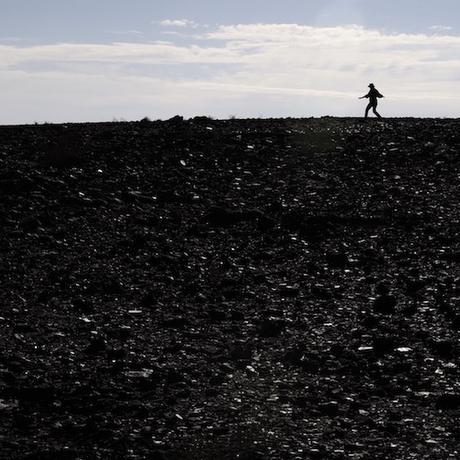
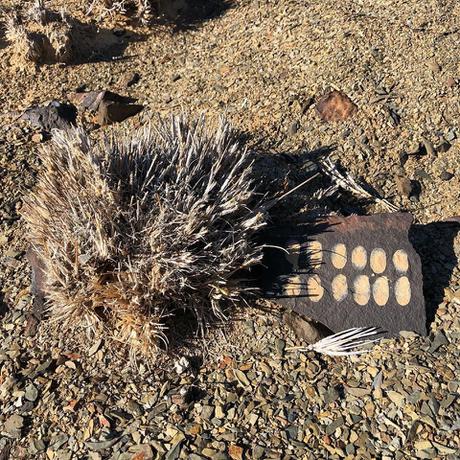
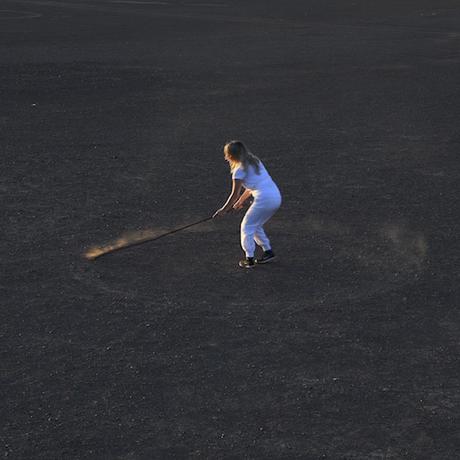
In my work with natural places, my general stance is to wait until I meet the site before deciding what my artistic response will be. On arriving in the Tankwa Karoo I took some time to perform a small ritual to introduce myself to the land. In the course of my introduction I explained that I have come to listen.
At first glance the Tankwa seems like a robust place made up of black gravel and dried out remnants of plants. The absence of movement because of the scarcity of water, plant and animal life gives the impression that it is a tough environment that could easily absorb and recover from encounters with human beings. I found however that its profound stillness shows the contrary to be true. Once I walked the terrain I noticed traces left by animals, water or human beings; timeless marks that seem impossible to date. It quickly became apparent that every stone I upturn, every footprint I leave might remain for many years to come; maybe even for thousands of years.
My first response was to create a short performance film where I walk bare feet and with great care across the horizon-line of the black landscape; taking great care not to leave evidence of my presence. What I did not expect was that the horizon-line I chose to walk was on a different level to the line my videographer chose. Thus at a certain point I started to descend into the darkness of the landscape and disappeared from sight. This is the power of making art: it can bring an expanded understanding of a simple idea. By walking on the land without wanting to leave a trace I was forgetting that I am inextricably part of this earth; that I will inevitably leave my spoor. It is how I walk, my intention when I walk, that makes the difference.
Dispersed throughout the dark landscape I noticed shining yellow holes exposing the ochre soil underneath the black gravel surface. I suspected these were created by porcupines digging up plant roots. I tested the clay soil with a little water and realized that it was a very good pigment for painting. So I did a small offering to the land and asked for some pigment. I explained that I make visual prayers with fingerprints dedicated to specific individuals and that I would like to create a 40 day prayer for this land in its ochre. I always click my fingers to acknowledge the ancestors of the land; as I did this the various insects in the little hole exited to create space. I collected about a cup of ochre from 3 of the porcupine holes. On my way back to the camp, I walked in one of the ancient dry river beds. Here I found a perfectly flat black slate stone. I mixed a small amount of clay with water and created 12 fingerprints onto the rock. Each one representing a prayer. We don’t know when the rain will come again, we don’t know if the wind will eventually blow the traces I left away. But I left a small prayer there in a location in the landscape we might never find again, so it will connect with the larger prayer I will be making once I return home. I created a short stop frame film of the print appearing and drying on the slate surface.
As an earth artist who has been working with rain and rivers for the past 5 years, being in a desert was confrontational. The traces left by water and rain can be seen throughout the land, yet there is no water to be found. In my work, rain has become a symbol of healing: as it surrenders to gravity rain ‘allows’ itself to fall into earth and thus life is created. In this contemporary moment it seems that almost everywhere I go to spend time in the natural world, I encounter damage inflicted by humans and I feel heavily burdened by the responsibility we carry to change our ways of relating.
The last place where I felt I should relate to the land was on the site where the Africa Burn event had recently taken place and desert workers were still clearing up the remains of the facilities. Remnants of the 12 000 people who had camped and partied there could still be seen and felt. Although all seemed neat and ordered on the surface, the place had the feeling of an aftershock; it reverberated with what I experienced as uncontained agitation.
My third response to the Tankwa was to do a ritual where I repeatedly draw a circle onto the surface of the earth around me. My initial performance was done in the morning as a type of rain dance with an Ostrich feather duster, since the sky was heavy with clouds. At the end of my dance a few heavy drops fell onto my face; a heart-warming moment.
Later as the sun was setting, I did another circular ‘dance’ with a found stick where I chased up the blonde dust under the loose dark gravel in circular motions. After a while one could see the circle I had drawn around me. I was accompanied by sound artist Quentin Green, who had made a bullroarer for the occasion. A bullroarer is an ancient ritual musical instrument historically used for communicating over great distances. The roarer is tied to a string and is then swung in large circular motions holding it in a horizontal plane. This creates an ominous roaring vibration. This ritual was a communication to the land; a signal that I listened and I heard. It was a prayerful offering to bring wholeness and containment again.
I created a short film of this performance which I paired with a poem by Afrikaans nature writer and poet, Eugene Marais (1871-1936), titled ‘Die Lied van die Reën’ [The Song of the Rain]. It is inspired by a San story about the rainmaker named Krom Joggom Konterdans who was known to be able to call rain. The poem is read by my mother Helena Conradie, who is a word-artist.
In response to my listening experience, I wrote a poem which is generated from the language of a magazine essay in Afrikaans from 1938. As an Afrikaner living in the years after Apartheid, my challenge is to integrate the older culture and its attitudes toward nature into who I am becoming today: An artist whose work relies heavily on animism as a cosmology. The poem describes in an older form of Afrikaans what I ‘heard’ when I was listening to the Tankwa Karoo. I list all I ‘heard’ and I comfort the reader that ‘in the silence of a vast heart’ it was listened to.
The Tankwa Karoo helped me to enter into a new way of being in relation to the vast mystery that is life. In its still immensity the desert removed all my usual reference points. In this stripped and vulnerable condition I managed to become porous enough to allow magical intimate connections to be made: with the natural world, with my fellow creatives and within myself.
